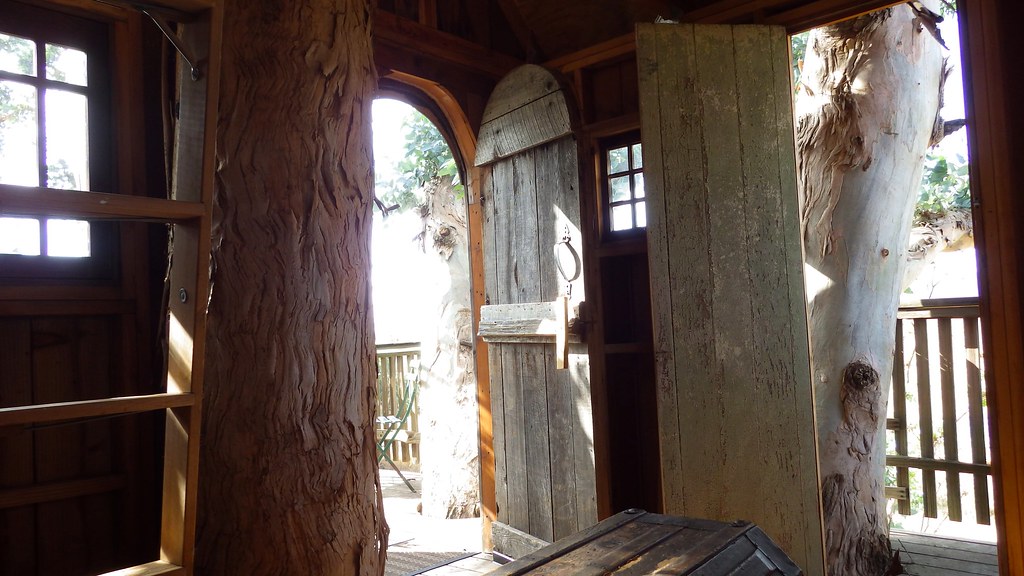 Fellow tea drinker Mat from Germany generously shared with me the paper "Identification and quantification of fungi and mycotoxins from Pu-erh tea" which I've read and reread to exhaustion. Instead of contemplating the bucolic views from this lovely treehouse yesterday, I hunkered down with this stiff yet illuminating scientific paper which offered a few nuggets to chew on. Much to my husband's delight on our anniversary weekend, I kept going on and on about mold and mycotoxins but he is used to my ways and is most willing to pay the price of admission as they say.
Fellow tea drinker Mat from Germany generously shared with me the paper "Identification and quantification of fungi and mycotoxins from Pu-erh tea" which I've read and reread to exhaustion. Instead of contemplating the bucolic views from this lovely treehouse yesterday, I hunkered down with this stiff yet illuminating scientific paper which offered a few nuggets to chew on. Much to my husband's delight on our anniversary weekend, I kept going on and on about mold and mycotoxins but he is used to my ways and is most willing to pay the price of admission as they say.(This off-the-grid treehouse had strict rules forbidding fires of any sort so I resorted to drinking pre-brewed aged oolong lukewarm in a thermos. Experience of sleeping three stories up in a tree felt very different than what I had imagined as a little girl. A living tree creaks and sways constantly and if I were to build my fantasy treehouse, I would build it in the shape of a boat.)
 This study published in the International Journal of Food Microbiology took 36 different puerh samples (25 loose tea of organic and conventional production, 11 compressed) and tried to isolate and identify the molds and mycotoxins present. The study does not explicitly indicate whether shu or sheng was used but I assume they used all shu samples as the authors describe the wodui process in the introduction.
This study published in the International Journal of Food Microbiology took 36 different puerh samples (25 loose tea of organic and conventional production, 11 compressed) and tried to isolate and identify the molds and mycotoxins present. The study does not explicitly indicate whether shu or sheng was used but I assume they used all shu samples as the authors describe the wodui process in the introduction.The authors found no less than 31 different molds with compressed samples being less colonized than the loose shu. Aspergillus acidus was identified as the main beneficial microbe in fermentation. Not all molds are beneficial and the study was looking for contaminant molds which could potentially produce cancer causing organ destroying mycotoxins. The study specifically targeted the following three fear-inducing baddies- aflatoxins, fumonisins, and ochratoxin A(OTA). I'm happy to say that only OTA was found in extremely insignificant amounts in only four of the loose shu samples.
How do these findings translate for the puerh drinker? One- it's always good news when mycotoxins are not detected in your favorite brew especially by those who might benefit by doing so. Three of the authors of this paper work for R-Biopharm that makes an Aflatoxin screener and so they would have had cause to try to find toxins in puerh. Two - you could rinse your pu at least twice but note mycotoxins are not water soluble and not all fungal spores are killed by boiling. Three- it appears there is more contamination risk in loose shu than compressed forms.
 So what should you do when you encounter white furry hairs growing on your pu? I keep small amounts of shu in ceramic jars to mellow out before brewing and this 2004 CNNP had developed a patch of white mold more than a year ago. Yes, even in cold dry Berkeley, this can happen even without the aid of a pumidor. This mold is pretty slow growing as it barely doubled it's size in a year. I couldn't bring myself to pitch it and kept it in the kitchen in case the taste developed into something special.
So what should you do when you encounter white furry hairs growing on your pu? I keep small amounts of shu in ceramic jars to mellow out before brewing and this 2004 CNNP had developed a patch of white mold more than a year ago. Yes, even in cold dry Berkeley, this can happen even without the aid of a pumidor. This mold is pretty slow growing as it barely doubled it's size in a year. I couldn't bring myself to pitch it and kept it in the kitchen in case the taste developed into something special. I tried to look up images for the molds in the above table for compressed shu. You can see that fuzzy stuff under macro is seriously filamentous white mold that hasn't fruited. I almost expected a tiny little spider to be doing a brisk business down there. I will need a more than a powerful microscope to be able to identify this bit of fuzz.
I read on tea forums that white mold is not cause for alarm and can be brushed away. But when encountering visible mold without positive identification, each tea drinker must assess their personal level of comfort in risk taking depending on their current health. Pregnant ladies and those with shot immune systems should take caution. But those willing to take the risk should consider the payoff. I brewed up the unaffected bits and it was boring old shu with the slightly metallic opening taste that did not get that much better. I pitched the rest. Had this been a twenty year old specimen with magical taste, I might have soldiered on.


No comments:
Post a Comment